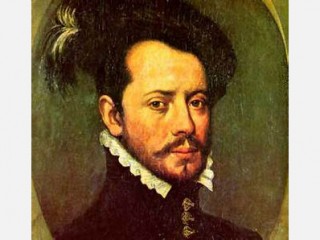
Antonio De Mendoza biography
Date of birth : -
Date of death : 1552-07-21
Birthplace : Alcala la Real, Spain
Nationality : Spanish
Category : Historian personalities
Last modified : 2010-12-17
Credited as : Viceroy in Mexic and Peru, ,
Antonio de Mendoza (1490-1552) was a Spanish viceroy in Mexico and Peru who inaugurated the system of viceregal administration, which lasted nearly 3 centuries.
Antonio de Mendoza was born near Granada into one of the country's oldest and most famous families. He entered the service of Emperor Charles V, for whom he performed a number of successful diplomatic missions in Italy. He was then selected to become the first Spanish viceroy of New Spain in the New World, where he arrived in 1535.
Mendoza proved a prudent, firm, and hardworking viceroy. He had the difficult task of consolidating the royal authority, correcting the abuses of tyrannical officials, completing the pacification and conversion of the conquered Indians, and promoting the economic prosperity of the new colony to the maximum advantage of the royal treasury.
Mendoza showed a patriarchal concern for the natives and did much to secure improved treatment and legal status for them. Any sign of rebellion, however, he ruthlessly repressed. Nor did he subscribe to the views of liberal advocates of Indian rights such as Bartolomede Las Casas, who persuaded the Crown to enact the New Laws of the Indies (1542), exempting the Indians from forced labor in the mines and on the lands of their Spanish masters. Convinced that this would only lead to economic chaos and drive the Spaniards to rebel, Mendoza suspended the New Laws until they were rescinded.
While suppressing an Indian rising, Mendoza's men had the good fortune to come upon the rich silver deposits of Zacatecas, which were to provide the Crown with one of its greatest sources of revenue from the New World. In addition to mining, the viceroy also encouraged the production of wheat, olives, silk, cloth, and cattle, and other such activities. His keen interest in exploration aroused the envy of Hernan Cortes, who had conquered Mexico and been rewarded with great estates there. Mendoza sent ships to explore the Pacific and in 1542 dispatched an expedition to the north under the command of Francisco Vasquez de Coronado in a vain attempt to discover the fabled Seven Cities of Cibola, which he believed to be a mightier empire than that of the Aztecs.
Worn out after 15 years of conscientiously discharging his varied duties, Mendoza requested permission to end his days in Spain. This was refused, and he was sent instead to Peru to consolidate the royal authority after a civil war among the conquistadores. One of his first acts there was to send his son to inspect and report on the conditions under which the Indians were working in the mines. Mendoza fell ill and died before he could introduce the reforms which he saw to be necessary but which needed to be tactfully implemented if the unruly Spaniards were not to be provoked to fresh unrest. He was remembered as a stern but humane and just administrator, genuinely concerned with the welfare of the people under his jurisdiction but loyally dedicated to the service of the Crown.
A full-length study of the viceroy's career and achievements is Arthur S. Aiton, Antonio de Mendoza, First Viceroy of New Spain (1927). For background see J. H. Parry, The Spanish Seaborne Empire (1966), and John Hemming, The Conquest of the Incas (1970).
















